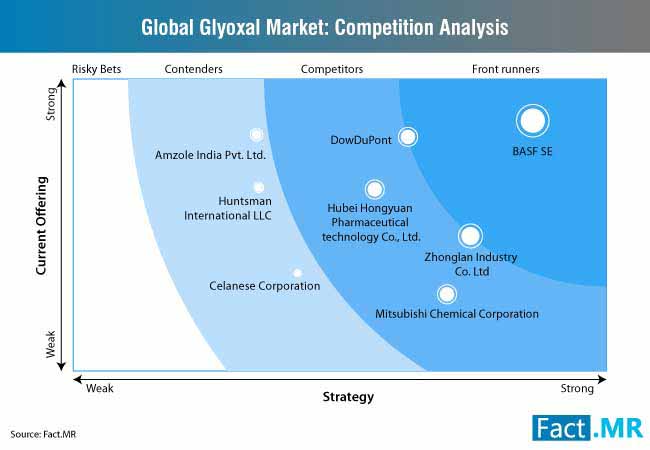
According to the latest study by Fact.MR, over 360 kilotons of glyoxal will be consumed in 2019 globally with a projected annual growth of 3.8% over 2018. Overall growth of the glyoxal market can be attributed to,
- Glyoxal to be used as an aldehyde substitute across end-user industries
- Development of biodegradable glyoxal formulations in tandem with the sustainability trend
- Versatility of glyoxal and its extensive application in multiple end-user industries ranging from textile to oil & gas
To remain ‘ahead’ of your competitors, request for a sample- https://www.factmr.com/connectus/sample?flag=S&rep_id=880
“Due to glyoxal’s divergent properties, the chemical compound is highly explored as a crosslinking agent in wood, textile and paper industries; as a sulfur scavenger and biocide in oil and gas applications and as an effective co-biocide agent in disinfection applications used in veterinary and health sectors. As glyoxal fits well in the sustainability trend, it is likely to become an important chemical intermediate for end-user industries in the future,” says Fact.MR.
Textile Industry Accounted for Over 51% of Glyoxal Consumption in 2018
According to the study, buoyancy in the textile industry will be beneficial for glyoxal market wherein over 51% of the global glyoxal is consumed by the textile industry. With the rapidly expanding urbanization and urban consumers spending more on high-standard clothing, the textile industry profitability is projected in the future.
With consumers demanding non-woven, soft and wrinkle-free clothing, utilization of glyoxal in the textile and apparel sectors is likely to increase in the coming years. However, with the advent of synthetic fibers, in the long run, application of glyoxal in the textile industry is estimated to decline.
Nearly 27% of the glyoxal consumption was held by the paper & packaging industry in 2018. Glyoxal finds an extensive application as a crosslinker in the paper & packaging industry. Glyoxal is readily biodegradable and according to Germany’s Federal Institute for Risk Assessment (BfR) and the U.S. FDA, glyoxal is categorized as an accredited chemical substance which can be used in paper for food packaging applications.
The study finds that the utilization of glyoxal in the personal care industry remains considerably lower. Glyoxal has been traditionally used as a synthetic preservative in the personal care ingredients and cosmetics. However, formaldehyde-releasing chemical compounds have been assessed for their harmful effects on skin and have been categorized as a carcinogen. Despite the use of glyoxal as an alternative to formaldehyde, the personal care and cosmetic industry’s increasing preference for natural ingredients is likely to reduce glyoxal utilization in the industry.
Oil and gas industry is another important end user landscape for glyoxal market wherein glyoxal is increasingly used in the oil extraction and enhanced oil recovery processes. Also, glyoxal is used as a sulfur scavenger in the gas sweetening applications. The oil production activities are growing in developed and developing countries, thereby providing opportunities for glyoxal manufacturers.
Get Access To Research Methodology Prepared By Experts- https://www.factmr.com/connectus/sample?flag=RM&rep_id=880
Nearly 80% of Glyoxal to be Consumed as a Crosslinking Agent in 2019
Application of glyoxal as a crosslinking agent has remained traditional across multiple end-user industries and the status-quo is expected to continue in the future. According to the study, nearly 80% of the global glyoxal was consumed as a crosslinking agent. Glyoxal provides a comprehensive crosslinking solution for a wide range of polymers such as starch, polyacrylamide, cellulose, proteinaceous material and polyvinyl alcohols. As manufacturers continue to invest more in R&D for the development of biodegradable glyoxal, its application as a crosslinking is likely to grow in the future.
The study opines that Asia Pacific excluding Japan (APEJ) accounted for over half the global glyoxal consumption in 2018 and the status-quo is expected to continue in the future with a 5.2% y-o-y growth in 2019. Of the regional consumption, China consumes over half the glyoxal, especially East China. The Pearl River Delta (PRD) region is known for the production of glyoxal from the oxidation of aromatics. North America and Europe registered the second largest consumption of glyoxal and collectively they consumed over one third of the global glyoxal in 2018.
The Fact.MR study provides a comprehensive analysis of the growth prospects and developments in the glyoxal market during the period 2018-2027. The glyoxal market is projected to grow at 4.2% volume CAGR through 2027.
Speak To Research Analyst For Detailed Insights- https://www.factmr.com/connectus/sample?flag=AE&rep_id=880
About Fact.MR
Market research and consulting agency with a difference! That’s why 80% of Fortune 1,000 companies trust us for making their most critical decisions. We have offices in US and Dublin, whereas our global headquarter is in Dubai. While our experienced consultants employ the latest technologies to extract hard-to-find insights, we believe our USP is the trust clients have on our expertise. Spanning a wide range – from automotive & industry 4.0 to healthcare & retail, our coverage is expansive, but we ensure even the most niche categories are analyzed. Reach out to us with your goals, and we’ll be an able research partner.
Contact:
US Sales Office:
11140 Rockville Pike
Suite 400
Rockville, MD 20852
United States
Tel: +1 (628) 251-1583
E-Mail: sales@factmr.com
Corporate Headquarter:
Unit No: AU-01-H Gold Tower (AU),
Plot No: JLT-PH1-I3A,
Jumeirah Lakes Towers,
Dubai, United Arab Emirates





